Johann Nepomuk Holzhey: Master Organ Builder of Southern Germany
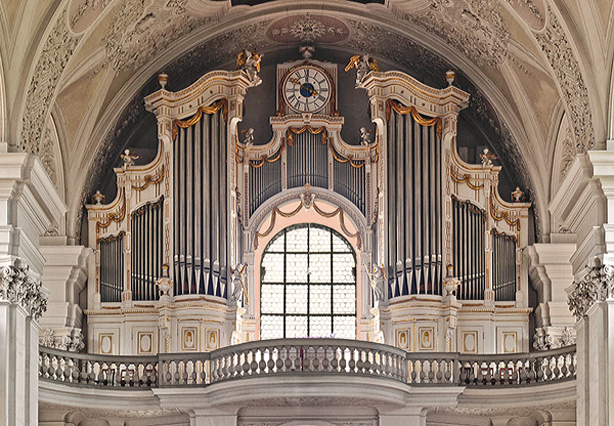
In the 18th century, Johann Nepomuk Holzhey was among the most renowned organ builders in Southern Germany. His distinctive personal style bridged the ornate Rococo and the emerging Classical period. With his instruments, the classical organ in southern Germany reached an artistic pinnacle.

He learned the craft of organ building from his uncle, Alexander Holzhey, who was strongly influenced by Karl Riepp. While Alexander remained rooted in the Central German tradition, Riepp leaned more toward the French style. Johann Nepomuk succeeded in blending these influences into instruments with a unique, well-balanced musical character.
His organs could sound both gentle and powerful, embodying a tonal quality closely aligned with the sound ideal of J.S. Bach.
The Holzhey Organ of Weissenau: A Masterpiece in Samples
The sample set of the Holzhey organ in Weissenau, developed by Prospectum, is a remarkable example of careful digital reconstruction. Housed in a church with cathedral-like acoustics, the grandeur of this instrument is beautifully captured in the sample set.
The stops reflect a tonal spectrum that transitions from Rococo elegance to Classical clarity. Each timbre is preserved with great precision, allowing the full range of tone combinations to shine — without disruptive volume differences.
It is a unique achievement to capture such a rich palette of tonal colors and integrate them seamlessly into the spacious acoustics of the original setting.
Perfectly Suited for Home Use
Thanks to its clear and dynamic sound, combined with well-balanced registration, this sample set is ideally suited for use in the home. From the gentle whispers of the Rococo stops to the firm foundation of the Classical pipework — everything is present to create a realistic and expressive organ experience in an intimate space.
Concept
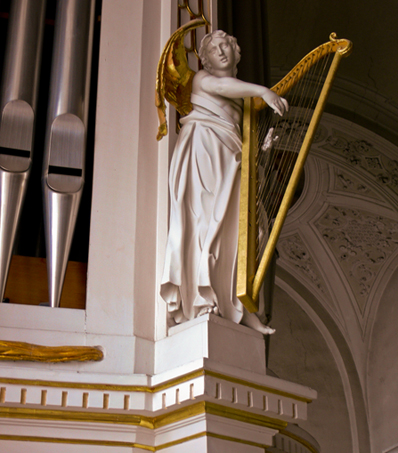
The concept of this organ centers on transparent sounds with exceptional clarity. The lower manual forms the Main Organ, where principals from 16’ up to the highest ranks of a 6-rank mixture create a brilliant Plenum. The sound is powerful, yet remains perfectly clear.
To faithfully reproduce these qualities in a home setting, careful intonation of the samples is essential.
Flutes and Strings
The Main Organ is enriched with a wide range of colorful flute stops, along with string voices such as the Viola 8’ and Gamba 8’. These stops are slightly detuned relative to each other, yet each retains a distinctive tonal character.
Reeds
A clear French influence is heard in the reeds, with their rich overtone structures. The sound emphasizes lyricism over sheer power. The Trumpet 8’ gains vitality when paired with the Claron 4’, while the Cornet blends naturally with the reed palette.
Positive

The second manual, the Positive, is a lighter version of the Main Organ, following South German tradition.
It is highly expressive due to stops such as the overblown Flaut Travers 8’, the intimate Stopped Flute 4’, and the Unda Maris 8’, tuned in slight opposition to the Salicional 8’.
The reeds on this manual include a Bassoon 8’ in the lower register and a bright Oboe 8’ in the treble. In a large space, these reeds sound transparent and subtly radiant.
In many large organs, the third manual often serves as a sharp Cornet division. In this instrument, however, it functions as an Echo Organ.
Placed behind closed doors in the lower part of the organ case, the volume is noticeably softer than on the first and second manuals.
The Echo division includes a wide-scaled Nachthorn 8’, a Dulciana 8’, and two soft flutes. For solo use, there are two reed stops available, enhanced by a singing Cornet.
French influence
The influence of French organ building traditions is unmistakable in this instrument. A Cornet—typical in French organs—is present here as well, though its tone is broader, reinforcing the color and warmth of the reed stops. By separating bass and treble, the organ allows for greater tonal flexibility and color variation.
This French character is also evident in the reed voices, with their rich and expressive overtone structure. Unlike the French Récit division, however, this organ uses an Echo manual, featuring two reeds with delicate, penetrating sounds. The Cornet here is not piercing but wide and lyrical, blending smoothly with the reed ensemble.
In the pedal division, both gravity and brilliance come from the trumpet family: Bompard 16’, Trumpet 8’, and Claron 4’. Holzhey did not include mixtures in the pedal; such voices are instead integrated into the Main division.
On the second and third manuals, Principal stops from 2’ and above are deliberately omitted. This opens space for a more expressive palette of string stops, flutes, and the bright shimmer of a Cymbal.
The French-style intonation is also recognizable in the sparkling reed tones of the Positive manual, particularly in the Fagott-Oboe 8’.
In the Echo division, the Vox Humana 8’ produces a serene and graceful tone of rare beauty. The acoustic of the large space gives it a distinctive glow that invites repeated use.
The second reed stop in the Echo, the Cromorne-Schalmei 8’, is broader and more open than the Vox Humana. It’s well suited for alternating use or for blending with it in solo passages.
Holzhey’s labial stops are somewhat more foundational than in earlier Baroque instruments, forming a stylistic bridge toward the Romantic era. Still, the core of the sound remains a complete Principal chorus in the Southern German tradition, marked by compound stops with thirds—such as the Sesquialtera, Nazard, and Mixture.
Organ case

This stylistic transition is also visible in the organ case. The ornate forms of Rococo give way to the more refined lines of Classicism. Holzhey did not build the case himself; carvers and cabinetmakers were commissioned for the work, as was customary at the time.
Only after the casework was completed did the actual organ construction begin. The earlier close collaboration between case design and stop layout was increasingly replaced by a more segmented process. The refined design of this case was commissioned by the Abbey’s construction director.
The organ features a freestanding console, placed before the west windows. As a result, the tracker action was often redirected to accommodate the position.
Still, Holzhey’s organs were known for their ease of play. As Ernst Ludwig Gerber noted in his Historical Biographical Lexicon of Sound Artists (1812), these instruments “play almost as effortlessly as a piano.”
Pipe scale
In some cases, Holzhey adopted pipe scaling directly from Karl Riepp, especially for the Principal 8’, which served as the tonal foundation in Baroque organ design. For the higher octaves, however, he applied his own acoustic insights. The result was a new, refined scaling system that formed the basis for his full Principal plenum, aligning him firmly with the South German organ tradition.
Stops such as Quint, Nazard, Sesquialtera, Hörnle, and Cornetbass were all built using Principal scaling. Since these pipes form the core of the Principal chorus, it means that around 54% of the pipework in Holzhey’s instruments consists of uniformly scaled Principal pipes.
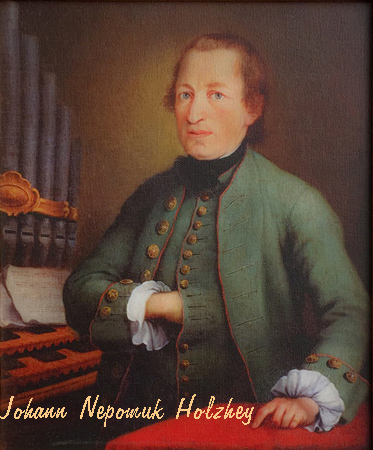
Only the Cornet—as a compound voice—was scaled wider, while its bass counterpart was again treated as a Principal in design.
Acoustic adaptation
Holzhey paid close attention to how his pipes interacted with the acoustics of the space. Key factors included cut-up height and airflow control at the toe hole, allowing precise adjustment for each room.
His string and flute stops in the Weissenau organ were customized with great care, tailored specifically to the room’s acoustic profile.
Tonal richness
This wide palette of colors—including beating stops, overblown flutes, Quintadenas, and string stops (also in 4’ pitch)—is a hallmark of the South German organ style. Holzhey’s treatment of timbre reflects both artistic sensitivity and technical mastery, creating instruments rich in expression and tonal beauty.
Excellent sample set
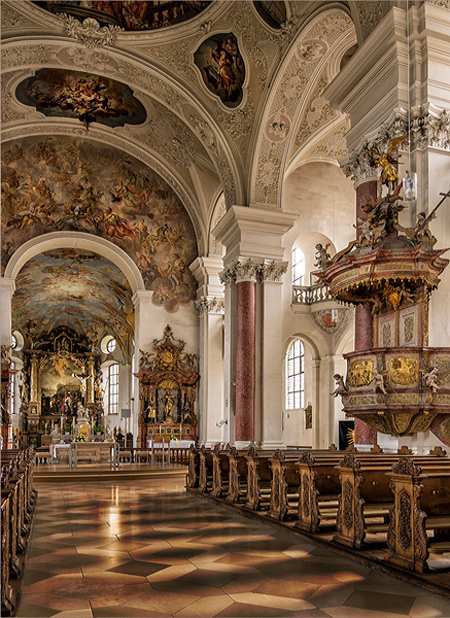
The sample set of the Holzhey organ in Weissenau, created by Prospectum, demonstrates a deep understanding of how to capture the sound of a large church organ with exceptional acoustics — and translate it faithfully into a home environment.
The generous acoustics of the Weissenau church present challenges in both preserving detail and conveying the sheer spatial depth. The microphone placement was carefully chosen: as close to the pipes as possible, while maintaining equal distance across the organ divisions.
This position allows the room acoustics to be present — enough to give atmosphere, but not so dominant that they mask the chiff or clarity of the pipe attack. It also helps capture how the tones blend naturally.
To complement this, a second microphone set was placed at a greater distance to record the full spatial impression. The result: the organist at home experiences the sound as if it’s in a large space — but without the overly reverberant quality of so-called “wet” sample sets, like those from the Bovenkerk in Kampen or the Dom in Utrecht, where reverberation often dominates the musical detail.
Custom acoustic balance
On the Weissenau sample set, the balance between tone and acoustic is adjustable per manual. For example, the Echo reeds can sound distant and atmospheric, while a second stop on the lower manual can be perceived clearly and closely at the console.
This flexibility gives organists more expressive control and a highly realistic playing experience.
Refined tonal palette
The organ includes a rich variety of 8’ and 4’ stops, not to amplify, but to color the tone with subtle nuance. These stops can be combined in countless ways to produce unexpected and expressive tonal blends.
- The Quintadeen 8’ stands out for its insistent yet melodic character.
- The Flaut Travers 8’ is an overblown flute, bright and colorful.
- The Copel 8’ and Nachthorn 8’ serve as more modest, gentle flute voices.
Tremulants in context
Tremulant stops were popular during the Romantic period, but they are not exclusive to it. Many Baroque organs, particularly in Southern Europe, already included them.
Over 400 years ago, Italian organs often featured the Voce Umana, a trembling Principal stop. Similarly, Heinrich Trost built Unda Maris stops in organs that were played and admired by J.S. Bach.
Joseph Gabler also included tremulants in the famous instruments of Weingarten and Ochsenhausen.
Holzhey, building the Weissenau organ 30 years later, followed this tradition. He installed trembling stops on two manuals:
- On the Main Organ, the Gamba 8’ with a beating Viola 8’.
- On the Positive, the combination of Salicional 8’ and Unda Maris 8’.
These stops contribute to the organ’s rich emotional expression, rooted in historical practice yet fully alive in a modern sampled instrument.
An ideal sample set
This organ provides an exceptional variety of timbres in the 8’ and 4’ range, without noticeable differences in volume. For a chamber organ, this richness in tone is more valuable than sheer power. That makes this a highly successful sample set for use in a living room setting.
Reed quality
Special care has been taken with the reed stops, and it’s clear that Holzhey favored the French style of bright, vivid intonation.
- The Vox Humana in the Echo division stands out for its serene and beautifully refined tone.
- The Oboe in the Positive manual has an equally sublime and expressive sound, full of character.
Emotional contrast
Each manual has its own emotional color and sonic atmosphere:
- The Main organ sounds broad and energetic,
- The Positive offers warm, colorful tones,
- The Echo is delicate and distant, with a soft, ethereal presence.
Every division can be placed in the virtual acoustic space according to the user’s personal taste, making the playing experience both realistic and customizable.
Buch Holzhey organ
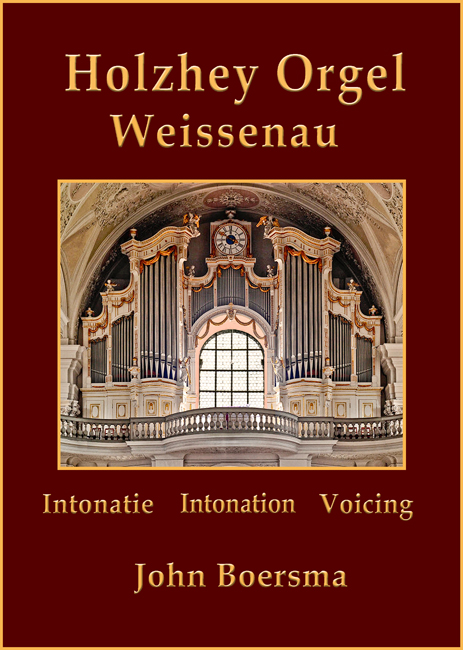
The Abbey Church of Weissenau is a large space with impressive acoustics. In this grand setting, the Holzhey organ resonates beautifully, and these rich, vibrant sounds are faithfully preserved in the sample set.
As someone experienced in intonating pipe organs, I’ve learned that adjustments are essential to make the samples sound in a home environment as they do in the original church. It is not easy to transfer the natural character of each stop into a living room.
After working carefully on the intonation, the Holzhey organ now sounds in my home exactly as it would to the organist sitting at the console in Weissenau. The sense of space and acoustics has been proportionally adapted to the domestic setting.
A book on the process
I wrote a book about this essential process of adapting a sample set to room acoustics. With it, any organist can achieve the same result.
The vast space of the church is proportionally scaled down, allowing the organ to sound powerful and brilliant in the living room—or subtle and distant, as it would in a large cathedral-like space.
